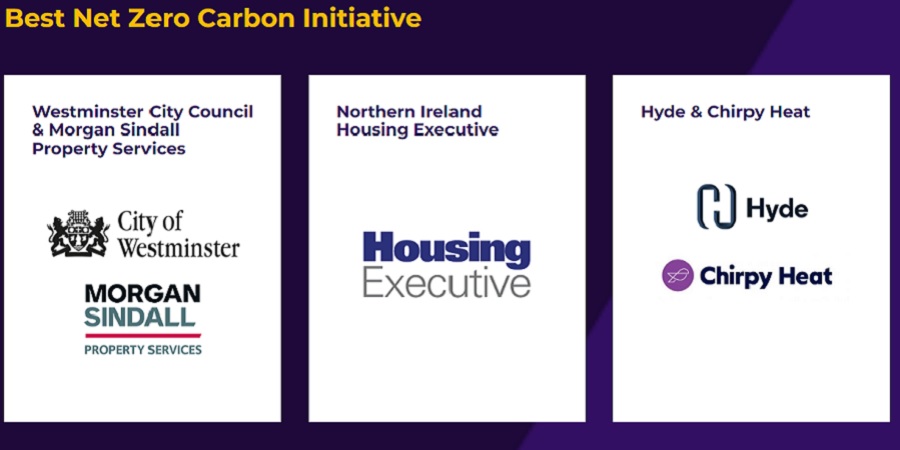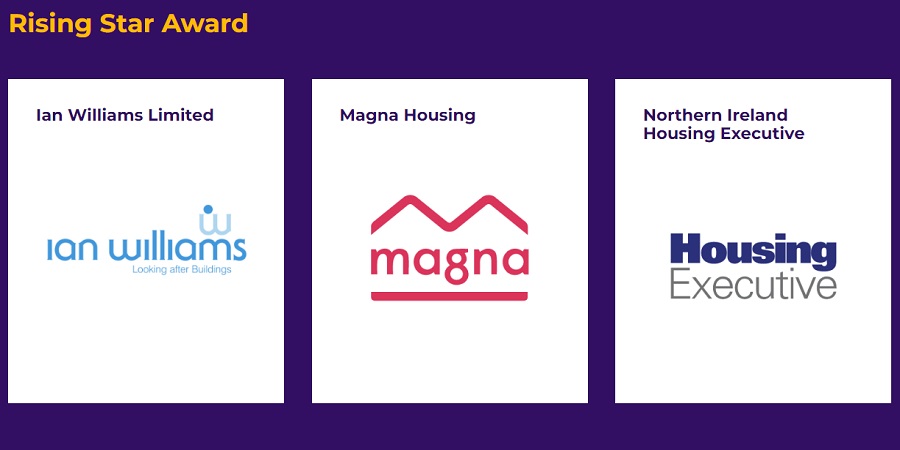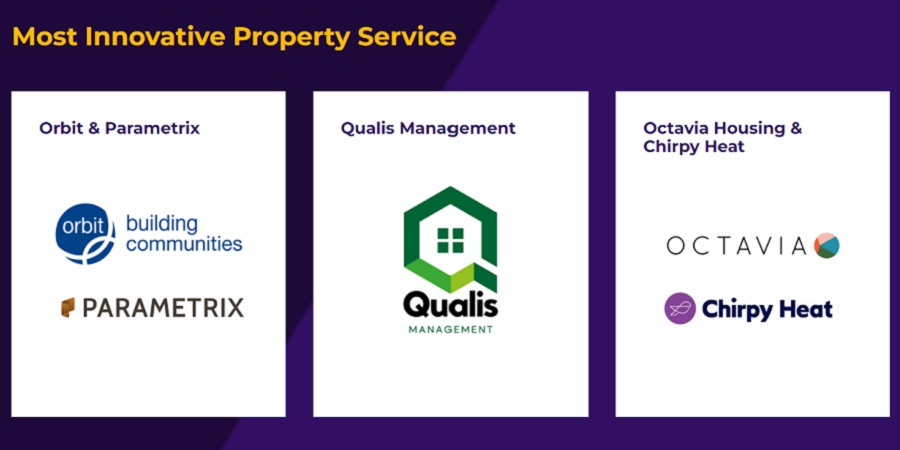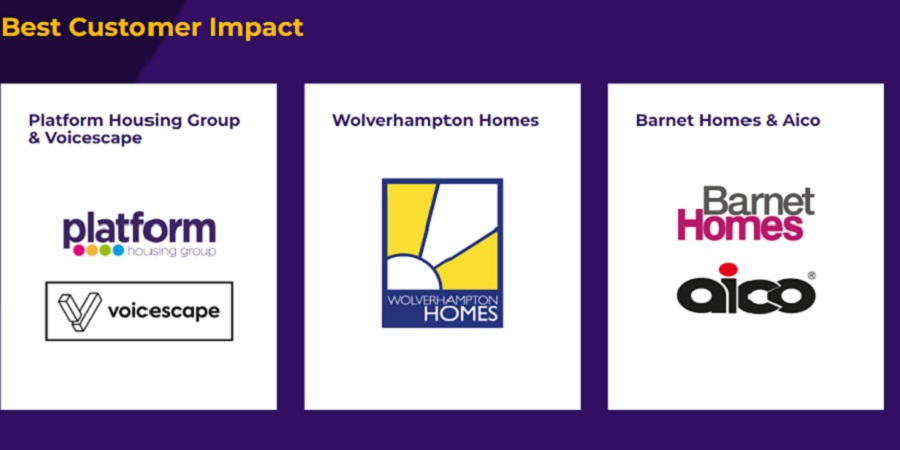NHMF Awards 2023: Best Net Zero Carbon Initiative
Shortlist Westminster City Council (WCC) & Morgan Sindall Property Services Northern Ireland Housing Executive (NIHE) Hyde & Chirpy Heat
 image source : NHMFWeb
image source : NHMFWeb
Judges’ comments
WCC submitted a very strong submission with a compelling business case (good ROI) with the use of IOT and the Home Health app to support decarbonisation. It was a great use of technology combined with a customer focussed approach using the app and nudge theory. Show home tours engaged residents resulting in fewer refusals and CO2, project costs and energy costs all being reduced to improve the quality of environment for customers, showing clear benefits to residents and WCC through a targeted repairs service. It is a great example of collaboration to deal with disrepair and early intervention using data sensors for potential disrepair claims and fuel poverty. The project is scalable, promotes best practice, improves VFM and Health. The project’s digital aspect is innovative and can be replicated by others. Also, residents are being trained to become assessors and advisors (something others are doing).
NIHE submitted a good scheme overall with ERDF funding being used to decarbonise and improve energy efficiency of 1900 homes. The project’s scale is to be applauded because most schemes retrofit about 200 properties. The works to No Fines homes (internal space retained and aesthetics improved) and installation of mechanical ventilation are also to be commended. It aims to reduce energy costs for customers and CO2. This type of project can be replicated because this work is already being adopted by others in the sector. The main issue is funding.
Hyde’s submission focussed on heat networks that are an often a forgotten part of the equation, with too many operating at poor efficiency levels. As such, it is certainly something other landlords with heat networks can do. A simple NROI approach was adopted (low ROI) resulting in clear benefits to the landlord, residents, and the wider community (other buildings on the network).
What is the project and what is innovative about the service provided?
Westminster has some of the highest carbon emissions in the UK, with buildings making up 86%. In response, Westminster City Council (WCC) committed to become carbon neutral by 2030. Improving the energy efficiency of residents’ homes is fundamental to achieving this. To help achieve the target, Morgan Sindall Property Services (MSPS), worked with WCC to create a bespoke retrofit programme, including a show home retrofitted with innovative Internet of Things (IoT) technologies to:
- Maximise take up of retrofit works by giving residents a “real life” experience of the benefits plus information and assurance about what is involved.
- Promote resident awareness and encourage behavioural change in energy usage
- Support residents in fuel poverty by improving the energy performance of their homes along with associated advice and support to minimise their fuel bills and improve wellbeing.
What makes WCC’s retrofit programme different from others, is the use of IoT technologies. MSPS’s data technology platform uses sensors to offer insights into properties’ internal environments, including internal temperature, carbon dioxide and humidity levels. Monitoring the internal air quality helps identify properties at risk of damp and mould, residents in fuel poverty, and energy-inefficient homes, for example those with insufficient insulation. Central to its solution is the Home Health app, which helps residents to improve the energy efficiency of their boilers, reduce energy consumption and minimise their energy bills. The app “nudges” residents to make better decisions within the home to use energy more efficiently and reduce their carbon footprint.
Northern Ireland Housing Executive (NIHE) has a goal to improve thermal performance within its stock and address Fuel Poverty by reducing energy usage and costs, while also contributing to the UK’s 2050 Net Zero Carbon target. NIHE invested in greatly improving the energy performance of nearly 1,900 homes across the region as part of a wider vision to create “Affordable net zero carbon housing that helps sustain the environment for future generations”. The Energy Efficiency in Social Housing project has been made possible by funding of €23 million from the European Regional Development Fund’s “Investment for Growth and Jobs Programme for Northern Ireland”. With a further €22 million invested by NIHE, the programme is expected to complete by September 2023, however this work will continue to develop its housing estates for future generations. The schemes address the level of thermal efficiency to various types of properties with the provision of external wall insulation, double glazing, and improved energy efficiency measures such as improved air tightness and mechanical ventilation. The works include two phases of projects to undertake External Wall Insulation (EWI) to No Fines non-traditional housing stock, throughout region the work will continue improving the quality of life for its tenants while bettering the local environment. Retrofitting has allowed tenants to live comfortably, with fuel efficiency high and emissions low, this allows parties to save money whilst producing an ability to attain a high level of customer service and tenant retention establishing a prosperous future for all with tangible investment completed.
Hyde recognised that low efficiency levels are common in heat networks across the UK, resulting in high energy costs and high carbon emissions. Improving the efficiency of such heat networks is crucial. To this end, Chirpy Heat has developed its Optimisation Study which provides solutions to:
- Lower carbon emissions
- Lower costs to heat network operators and their customers
- Provide effective optimisation measures that give maximum improvement at the lowest possible cost.
The entire heat network is investigated to determine where and how these savings can be made, including the distribution pipework, dwellings, and plant room. The cost, payback period, cost per tonne of carbon and net return on investment are shown for every identified measure, along with priority measures or "easy wins."
What are the measurable benefits to the client, the contractor, the resident, and the neighbourhood?
WCC’s Resident Engagement show home tours led by MSPS resulted in over 135 visits (public tours and individual visits) by Westminster residents. The team have seen:
- 25% increase in uptake of retrofit measures since the show home opened in July. Debunking myths and answering questions on the impact of the measures gave residents a better understanding of the long-term benefits and the confidence to take up works. Currently, there are 360 houses in Westminster with retrofit measures installed, and an additional 150 homes in the pipeline during 2022/2023.
- Feedback from the tours scored an average 4.5/ 5 rating; with those attending more likely to take up retrofit works. Susan, a Little Venice resident, said: “It was enormously helpful - in 10 minutes I could see and understand the improvements and the technology, which would have taken me several hours of research on the internet.”
- Preventive Maintenance according to Inside Housing, in 2019 / 20 “Registered Providers in England spent £5.51bn on repairs and maintenance, with many experiencing double digit increases in costs year-on-year.” Helping landlords identify potential maintenance issues before they occur by using IoT technologies like sensors could help councils like WCC save over £550m/yr. and reduce repairs demand, improving customer satisfaction, and helping spot potential indicators of vulnerability such as fuel poverty.
- Carbon Zero Goals – retrofitting homes will help WCC achieve its goal of carbon neutrality by 2030, saving 2.5 tonnes of carbon emissions/yr.
- Residents could see retrofit measures in an actual home including:
o internal wall and underfloor insulation
o secondary glazing,
o solar PV system,
o sensors to monitor wall temperature and humidity,
o replacing the gas boiler with an energy-efficient air source heat pump.
- Residents learnt about the benefits including:
o Reducing energy usage – improving the EPC rating from an E/D to a B
o Reducing the home’s heat demand by 55% per year and energy bills by about £250/yr.
o Recommendations through the Home Health app to homes more energy efficient, e.g., using heating more effectively throughout the day, the best time to run energy-hungry appliances and when to open windows to prevent condensation-related mould, creating healthier, comfortable homes, enhancing wellbeing, reducing the risk of illness related to poor air quality and the cold
- Supporting Vulnerable Residents – as part of the retrofit programme, the MSPS social value team hosts energy cafes for residents, providing advice on reducing energy usage and the best heating controls, and promoting awareness of retrofit measures. For residents struggling to pay bills, they signpost resources and provide energy redress fund vouchers. For the neighbourhood:
o Reducing reliance on fossil fuels means that residents are less likely to experience fuel poverty, resulting in a better quality of life
o Creating jobs and stimulating economies through investment in the built environment
o Reducing greenhouse gas emissions and contributing to city and national targets to tackle climate change.
NIHE through its ERDF Programme has an aim to improve the overall performance of its properties creating a more sustainable future for all parties involved. One benefit is that its contractors on these works have created employment opportunities for staff and benefit from a more secured business future with a plethora of works accessible for tender throughout the region. The opportunities have allowed for its contractors to plan longer term with a creation of further revenue and the ability to upskill and develop new members of staff in specialised types of ERDF works. This employment and training opportunity allows contractors to fulfil their social clause obligations while creating prospects for the local community. These opportunities created by NIHE has allowed the development of relationships with its contracting parties creating a more prosperous future for all parties involved, the opportunity has allowed its contractors to develop and become more workable, appealing, and versatile on the open market. NIHE through its ERDF Programme has been able to assign budgetary values to the improvement to the overall performance of its housing stock, creating a more controlled finance management environment to provide assurances for its stakeholders. The improvement of its housing stock creates a more sustainable future for all with the creation of a more enthralling product assuring its key stakeholders that investment and goals are being accomplished. The consistent investment in its products develops its relationships with the various stakeholders involved to allow creation of a long-term goal setting for all parties and create a more assured environment both in relation to compliance and governance creating much less risk for the business. Its residents benefit greatly from the investment made through its ERDF Programme, properties that have not reached the standard required for a modern home are selected and improved, with SAP ratings greatly improved in many cases, this improvement allows its residents to use less energy and resources to heat their homes with the current economic climate this is an approach that has been greatly received. Areas in which ERDF Programme works have been completed have been revolutionised creating an improved facade with a modern streetscape whilst increasing the overall value of the properties due to the investment made. With the approach implemented to improve the performance of our properties fuel poverty concerns have been lowered with a reduction in CO2 by-products being released into the environment therefore contributing to the UK goal of 2050 Net Zero Carbon target, this approach creates more sustainable prosperous future for all parties involved.
Hyde estimates, based on Chirpy Heat’s optimisation studies for some of the UK's largest Housing Providers and implementing innovative measures, that over 3500 tonnes of carbon emissions will be avoided and in excess of £170,000 of financial savings after costs over the next 20 years.
What are the financial costs and measurable cashable benefits over a defined time period?
WCC the cost of the show home was close to £40k, with the cost of each measure, annual energy savings expected per year (based on April 2022 energy price cap) are listed below.
- Wall insulation £4,000 giving annual saving of £136
- Underfloor insulation £3,000 giving annual saving of £57
- Window improvements £3,500 giving annual saving of £66
- Door replacements £1,500 giving annual saving of £8
- Air source heat pump and new radiators £10,000 giving annual saving of £22
- Waste water heat recovery system £2,000 giving annual saving of £22
- Solar panels and battery storage £8,000 giving annual saving of £934
Measurable Cash Benefits from the retrofit measures mean that the show home’s heating will be reduced by 55% (saving the resident over £18,000 in heating bills at 2022 prices over the next 30 years). In addition to the cash benefits the home’s carbon emissions have been drastically reduced. Using a full SAP model, it shows a saving of 60% initially but this will increase until the grid is decarbonised. Using temperature and humidity monitoring, the property services teams can pick up the conditions that may lead to damp and mould before they are reported by residents. By presenting the impact of retrofit energy works such as sensors, via the dashboard, WCC can see the tangible benefits of work carried out. This can be used for future projects and provide the evidence required to obtain decarbonisation funding, such as the SHDF which matches the landlord’s financial commitment to retrofit works.
NIHE have programme-level strategic targets for increased numbers of properties with improved SAP scores, reductions in both energy use and carbon emissions. In summary, the analysis to date demonstrates average improvements per property with an increase of 13.35 points in SAP score from pre-works 57 to post-works 70. When the programme has finished, it is anticipated that energy use will be reduced by over 9.15 million kWh/yr. and in carbon emissions reduced by over 3,051kg/yr. Some calculated estimates of cost savings indicate an average saving of £439/yr. (sample of the aluminium bungalows), and an average saving of £300 - £400/yr. (sample of the no fines properties0. However, with the current increase in fuel costs, potential savings to tenants could increase, which means thermal improvement works becoming more valuable and necessary over time. Finally, a key impact is customer satisfaction within communities. Initial feedback has shown the works have made important improvements to the health and wellbeing of tenants in the communities. Recent feedback has shown tenants have been delighted with the works and have noticed massive how much better their homes retain heat so that in the mornings, instead of turning on the heating, they are opening windows. The retrofit works are creating warmer, healthier homes that are easier to run and save money for tenants.
Hyde explained that the financial cost to housing providers varies depending on which measures are identified at a particular scheme. The total cost for measures identified by Chirpy Heat was just over £722,000 over 20 years, with the savings on energy bills being in excess of £897,000 over the same period.
How relevant is this as an example that might be followed by other organisations?
WCC’s project provides a great example to demonstrate what can be achieved by local authorities and contractors taking a holistic approach to retrofit programmes and using them as an opportunity to deliver carbon net zero along with wider strategic goals and initiatives such as:
- Proactive property repair and preventive maintenance that reduces disrepair claims and improves resident satisfaction.
- Delivering other planned investment, fire and building safety works
- Positive Resident engagement, in line with the principles of the Social Housing Regulation Bill, so that resident take-up is maximised and they are satisfied with retrofit works. The app promotes behavioural change to support residents reducing their energy use and minimising bills.
- Social value impacts including:
o improving resident wellbeing and financial resilience, and tackling fuel poverty
o promoting digital inclusion by supporting residents to use the home health app
o providing training and employment opportunities for residents, for example to become Retrofit Assessors, Resident Liaison Officers, or Site Supervisors
o promoting the green economy and investment in local communities through using local suppliers and SMEs to deliver the retrofit programme.
Throughout the project WCC and MSPS were very much aware of the uncertainty residents felt and feel about getting any work done to their property. But while achieving net-zero is essential, the team made sure that resident comfort and wellbeing was always a priority. Creating the retrofitted show home was central to the success of the programme: it enabled early, “real life” interaction and engagement with residents about having the works done and the benefits those would bring. The reduction in carbon emissions also demonstrates that it is possible for existing housing stock to be upgraded in line with the demands of modern living. By embracing IoT technologies, other local authorities and housing associations can better manage and maintain their housing stock and gain insights that will benefit residents. Proactive identification of issues via IoT technologies like property sensors will enable landlords to intervene early to:
- address problems related to condensation, damp, and mould
- support vulnerable residents including those in fuel poverty
- develop retrofit programmes targeted on properties with the worst energy performance
- rectify water or carbon monoxide leaks
- monitor water tanks for legionella
- monitor fire doors, with automated alerts generated when doors are left open for too long.
NIHE’s programme is improving thermal performance and desirability of its non-traditionally constructed properties that had poor airtightness and water penetration creating a poor living environment with excessive heat loss for occupants. Its Quality Improvement team focused on innovative good quality external design solutions to create warmer more desirable homes without reducing the internal space of our homes. The energy efficiency works adopts a “Fabric First” approach promoted by Home Energy Conservation Authority (HECA). External envelope performance has improved heat retention, air tightness and ventilation, preparing the property for decarbonised services and renewable technologies. The works included EWI, loft insulation, windows, doors, airtightness works and de-centralised mechanical extract ventilation units. Works must be installed and commissioned by a PAS 2030 certified installer to ensure a high specification is achieved. Works also include aesthetic features including K-rend external finishes, roof replacements and modern external fixtures including GRP canopies. Significant roof replacement works were completed ensuring the lifespan of the homes is extended and they are futureproofed. Over 250 homes have received retrofit work with further properties being completed each month (12 thermal efficiency schemes throughout the region). Programme-level strategic targets have been set, with improved SAP scores and reductions in both energy use and carbon emissions. Analysis demonstrates improvements per property with an increase of 13.35 points in SAP score from pre-works 57 to post-works 70 on average. By completion it is anticipated that there will be a reduction in energy use of over 9.15 million kWh/yr. and a reduction in carbon emissions of over 3,051kg/yr. Estimated cost saving indicate that £300 - £400 can be saved annually and with the current economic climate the improved thermal performance has increased savings in fuel costs making the works more invaluable. Key challenges included a lack of a specialised workforce capable of completing works showed the need to upskill the workforce and provide them with the relevant skills and qualifications. This will have a positive impact in future retrofitting with works becomes more accessible, supporting increasing demand due to the current energy crisis and the importance of making NIHE’s homes more sustainable to significantly reduce its carbon footprint and helping to reduce running costs. Feedback indicated the works have improved the health and wellbeing of tenants, who have been delighted at the works, citing a noticeable improvement in heating. NIHE is creating warmer, healthier homes more efficiently and leading the way in retrofitting social housing.
Hyde by looking at its existing housing to identify all the ways efficiency could be improved, costs lowered and carbon emissions avoided, demonstrated what is crucial for the heat network industry to demonstrate their value as part of the UK's carbon emissions targets. Existing heat networks must be improved across the entire network, not just in certain areas, so that the best performance can be achieved and targets can be reached.


